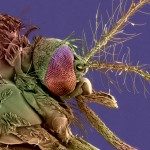Lien vers Pubmed [PMID] – 12669664
Bull. Acad. Natl. Med. 2002;186(7):1237-48; discussion 1248-50
Aedes aegypti is the main vector of dengue viruses. Methods for limiting the spread of dengue outbreaks are currently based on vector control. Estimates of population genetic organization and gene flow with respect to vector capacity have provided great insights into dengue epidemiology. In Vietnam, dengue hemorrhagic fever was detected in the 1950’s and becomes today the major problem of public health. Among factors influencing dengue epidemiology, ecological disturbances have a direct impact on vectorial system functioning. Human activities through urbanization creating sanitary conditions are convenient to the vector proliferation and then, to dengue endemisation. To assess the role of the vector in the changing pattern of dengue in South-East Asia, we studied the genetic differentiation and the vector competence towards dengue 2 virus at two scales: at a spatial level (a local scale (i.e., Ho Chi Minh City) and a regional scale (i.e., Cambodia, Thailand and South Vietnam) and at a temporal scale. This study allows to propose a model of Ae. aegypti population functioning according space and time. Dynamics of dengue virus diffusion in relation with the vector, depend on the population genetic composition and its evolution.

